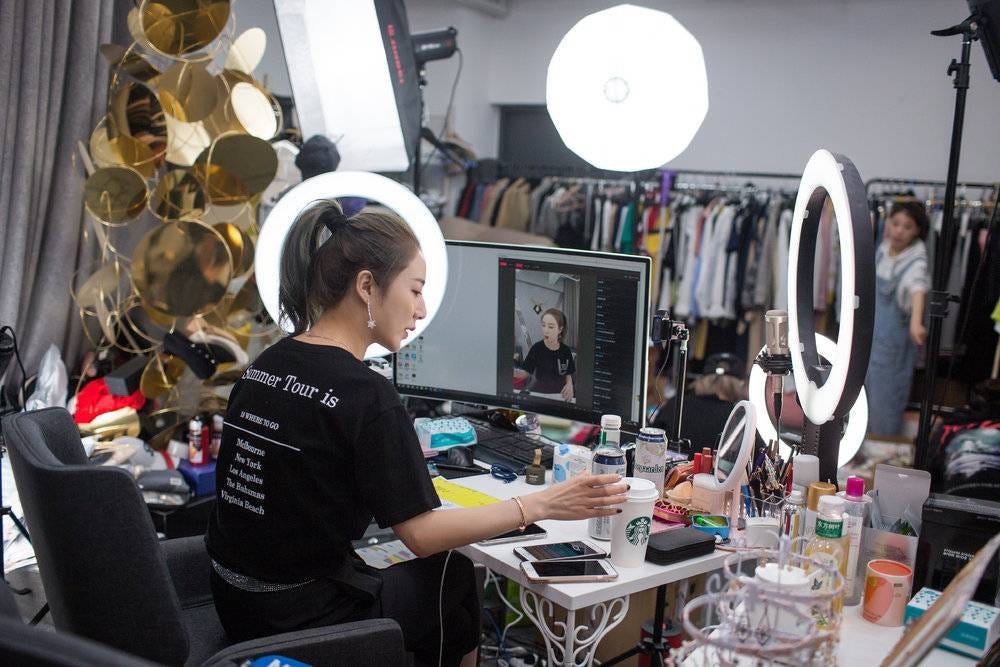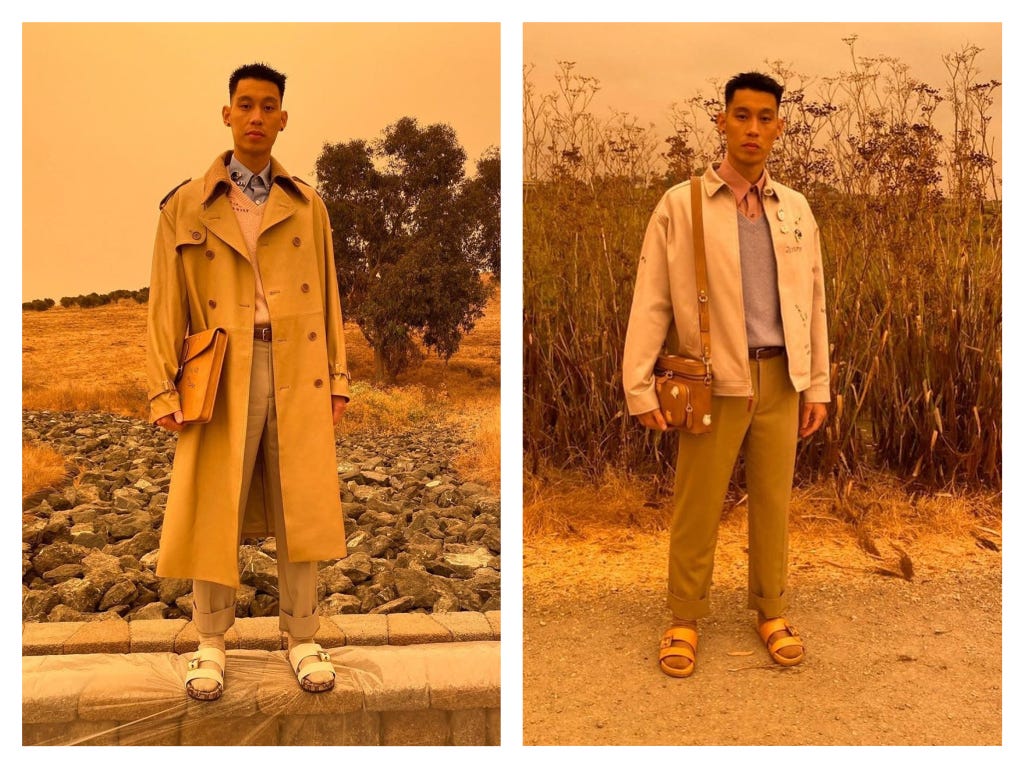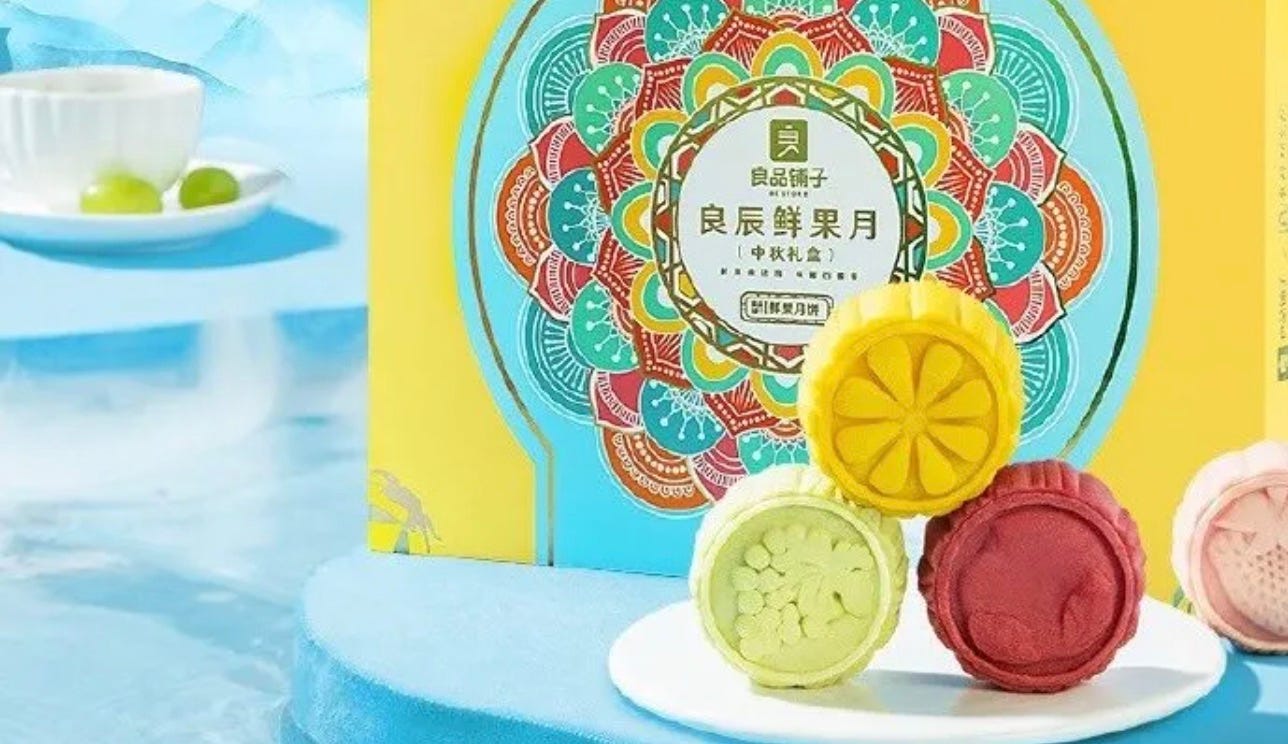How Chinese Tech Builds Trust, Part V: Influencers Are Judged on Followers, KOLs Are Judged on Sales
Plus: Coach courts controversy, Nike's content-commerce prowess, and our News in China roundup.
The Content Commerce Insider newsletter is published twice weekly (Tuesday/Thursday) and focuses on how brands create content to drive revenue. If you have received our newsletter from a friend or colleague, we would love for you to subscribe as well.

A little more than a third of humanity regularly uses a Facebook app or website. That's a ton of people who love content. Meanwhile, some 72% of young Americans follow at least a few influencers.
For all their media exposure and disruption and glory and billions, the Instagrams and WeChats of the world don't actually make any content. They write the rules and laws that govern much of our digital lives, but they are not creators, they are facilitators.
Every minute, 300 hours’ worth of video is uploaded to YouTube. The effort expended in producing this content is mind-boggling. Is anyone getting compensated? Maybe. Who’s doing the compensating? Major brands, mostly.
What Happened?
By most standards, Facebook created the world's first successful social network. Some of that is attributable to just solid engineering, but great timing played a larger role. By 2009, hardware and infrastructure formed a base that allowed a new wave of internet companies to take off.
Sharing photos is easier than sharing text. Open the camera app, point, tap, and poof — you've contributed content to the world wide web. The first 3G-enabled iPhone came out in 2008, the same year Facebook gained mainstream popularity, surpassing Myspace in terms of visitor numbers. The combination of social networks, faster internet speeds, and powerful phone cameras led to a massive uptick in amateur user-generated content. The addition of a selfie camera to the iPhone 4 and the launch of Instagram, both in 2010, really gave legs to the content economy.
Who Wants What
Social platforms need users. Lots of them.
There are two main types: creators and consumers. Consumers want great content. Social media companies facilitate content creation by creators, and its consumption by consumers.
These facilitators want users, and consumers want content, so what do creators want?
A whopping 54% of young Americans say they’d like to become influencers, but there is a steep cliff between aspiration and reality. That divide is bridged mostly by cash, or not at all. Millennials and Gen Zers might prioritize their impact over their earnings, but that doesn't negate the reality of having to put bread on the table. Content monetization relieves creators from the stress and time commitments of a “day job.”

Source: Morning Consult
Ideally, facilitators would incentivize creators to build quality content for their content consumers. To its credit, YouTube does this, and in China, so does Bilibili, to an extent. Others do not.
Are social media titans such as Facebook, Instagram, TikTok, Twitter, WeChat, and Weibo falling prey to short-term thinking? Not really. What happened is that social algorithms downgraded brand and media content in favor of content from influencers and friends.
In other words, platforms made themselves pay-to-play for brands and media companies. So newspapers, for example, promoted self-branding by their reporters on Twitter instead of their own official accounts. Brands pivoted to leveraging influencers and micro-influencers across the board. Essentially, they are funding content creators for the consumers. Marketers use LinkedIn personal pages to shamelessly plug their firms. It's all blending into a grey-brown mix of personal and professional. Why does that sound familiar?
Culture Reflects on Tech
The personal and professional go hand-in-hand very well in China, where couriers, colleagues, and clerks alike have asked me matter-of-factly about my income, in a way that feels both polite and refreshingly mundane. Money is talked about openly. And encouraged.
Whereas media outlets seem to feature a never-ending barrage of stories about millionaire YouTubers, the reality is much bleaker. American creators face immense pressure to refrain from posting branded content for fear of being seen as a sellout. The optics of that status would drive down their key metric for any monetization opportunity: followers*.
Contrast the situation in China, where consumer attitudes towards content-commerce run along the same lines of the couriers and clerks asking about how much I earn — these are standard and accepted practices.
Chinese consumers recognize that need for bread on the table and accept creators who abide by the rules of a modern economy, namely, that the expenditure of labor and time deserve commensurate compensation. They also often see key opinion leaders (KOLs) as entrepreneurs, rather than pure "creators.” That's because Chinese platforms have never paid creators, and influencers had to get much more creative with monetization. Brands are happy to partner with them more too, given targeted advertising doesn't work in China and KOLs offer the most targeted approach for ads.
Amongst other things, American influencer Kylie Jenner is famous for commanding up to $1 million for one ad placement. China’s leading e-commerce livestreamer Viya is famous for selling a lot of everything, including five rocket launches at $6.3 million each. Chinese media are very straightforward about how much top sellers earn.
Media reporting on influencers inside and outside China differs in one key way. Globally, influencers are judged based on follower counts and engagement metrics — it’s all about exposure (the bread). Their Chinese counterparts, known as KOLs, are judged on sale conversions (the meat). Creators reflect the platforms they use. In the international market, advertising drives platform revenues, while in China, it’s e-commerce.
The Bottom Line
Overall, there is still not enough understanding of the need for branded content.
Consumers should realize that influencers have no other choice.
Brands should realize how desperate influencers are for well-integrated branded content.
Influencers should realize that well-integrated brand content is possible.
- by Tanya Van Gastel
*Subscribe to the CCI newsletter to read the next article in the series on content integration and how Bilibili is building it up in China
Mentioned in today’s newsletter: Alibaba, Arc’teryx, Bestore, Bilibili, Coach, Dior, Facebook, Instagram, JD.com, Kuaishou, LinkedIn, Luckin Coffee, Nayuki Tea, Nike, TikTok, Twitter, WeChat, Weibo, Youtube, Zhihu.

Coach Courts Controversy in Both U.S. and China With New Jeremy Lin Campaign
by Sky Canaves

Back in May, American luxury brand Coach appointed NBA star Jeremy Lin as its second-ever menswear brand ambassador. It was the American-born Chinese player’s first endorsement deal with a fashion label, and marked Coach’s emphasis on reaching male consumers in China, where “Linsanity” took hold early on, and saw a resurgence after he moved to play on the Chinese Basketball Association’s Beijing Ducks team in 2019 (he announced his departure earlier this month and plans to try for an NBA comeback.)
But Lin’s debut campaign for Coach looks like it could flop in both the United States and China. Shot by star fashion photographer Juergen Teller in Palo Alto, California, the two rather sepia-toned images released so far show Lin dressed in an awkwardly retro style, including rolled-up pant hems and socks with sandals. Lin’s caption to his Instagram post of the photos reads: “I dont usually match my outfits to the sky but 2020s been something different loll.”
On Coach’s Instagram post of one of the images, several commenters questioned the choice of backdrop — a sky tinged an apocalyptic orange by the smoke of the wildfires that have raged in the region — to market luxury fashion. “Coach please don’t tell me the backdrop is from wildfires..please no..I am a super Coach fan..if it is please apologize, delete and make some sort of donation,” wrote one follower.
Meanwhile in China, Coach’s Weibo post of the campaign has drawn scorn for its application of the “Too Cool” aesthetic to the beloved athlete. “Why do you always have to photograph my hero like this?” wrote one commenter. “Jeremy Lin looks like a village cadre!” wrote another. “This photo can only be described as gloomy and ugly.”
Lin’s Instagram fans are also weighing in on the styling of the shoot, with Chinese-American users commenting that he looks like their fathers (or even grandfathers) back in the day. “You look like the pictures of my ancestors when I look in those glass cabinets that my parents used to keep all their chinese artifacts,” wrote one.
While unlikely to reach the scale of last year’s calls for a boycott of Coach following the discovery of Hong Kong and Taiwan listed as countries on a line of t-shirts from the brand, the campaign highlights the often-seen mismatch between what’s trending among designers and creative directors and what will resonate with consumers who see luxury brands and their celebrity representatives as models of aspiration. In this case, Lin’s fans may have preferred to see him portrayed in a manner that would showcase his talent and iconic appeal, not one that makes him look like someone’s grandfather in rural China.
CCI Take: Nike’s China Playbook is Content Commerce Near-Perfection
by Avery Booker

With a presence in mainland China going back nearly four decades, Nike is one of the most recognizable brands in the country and has been instrumental in the growth and development of team sports such as professional basketball and, more recently, fashion trends in sportswear, athleisure, and streetwear.
But where the brand really stands out and offers lessons for any company interested in the market is in its ability to constantly experiment and fend off a vast array of foreign and domestic competitors. When Covid-19 hit China at the start of the year, Nike was forced to close brick-and-mortar stores, but made a rapid-fire pivot to digital content-commerce. The brand launched a special series of workout videos and livestreams featuring local coaches and trainers. This digital content was widely distributed: In addition to appearing on Nike’s own app, it was shared via Douyin, Tencent livestreaming and a WeChat mini-program, much of it offering a smooth path to online purchase.
Even as life has returned to relative normalcy in China, Nike has kept its foot on the gas, sharpening its focus on direct-to-consumer (DTC) and content-commerce marketing.
Read the full article on Content Commerce Insider
Brand Film Pick: Dior Brings Its Blockbuster Exhibition Into Virtual Reality

In July, the luxury fashion house Dior opened one of the world’s first major exhibitions of the post-Covid era in China, bringing its “Christian Dior: Designer of Dreams” show to the public at the Long Museum West Bund in Shanghai. Following previous stops at museums in Paris and London between 2017 and 2019, the Chinese edition is even larger than its predecessors, with some 275 couture pieces, original illustrations, and additional works by Chinese artists such as Xu Bing and Gao Weigang.
The blockbuster retrospective has drawn big crowds in person and has been hugely popular online as well, with the show’s Weibo topic drawing 760 million views and nearly 6.9 million posts, thanks in part to intensive marketing efforts that included virtual tours with celebrity ambassadors, audio interviews, and short videos.
To further enhance the digital experience for those who cannot visit in person (along with those who may wish to revisit from home), Dior partnered with artist and director Shi Xiaofan and Huawei to produce an immersive short film, “A Summer Night’s Dream” (夏夜之梦). The film stars actress and model Sun Yihan as she takes in the hundreds of dresses on display in a darkened gallery, first exploring slowly, and then racing through the swirl of styles. The film can be viewed as a regular video, but may be best appreciated in a virtual reality version through Huawei’s VR glasses and through its VR video platform.
News From China

China’s biggest e-commerce players are already gearing up for the world’s largest shopping event, Singles’ Day on November 11, which will take on special relevance this year as the next major indicator of China’s ongoing consumer recovery.
Content will be key to boosting sales, not just on Singles’ Day but in the weeks of promotions leading up the big day as well. Alibaba and JD.com will launch pre-sales on October 21, and the need to sustain consumer interest will drive competition. On September 15, Alibaba’s livestreaming platform Taobao Live announced some of its strategies, with Alibaba VP Ping Chou outlining improvements in mobile layouts and updates to short video features.
Under a new “Anchor Growth System” (主播等级成长体系), livestream hosts will be classified under five levels, with factors such as number of livestreams, viewership, and sales determining placement, adding a gamified competitive element to this year’s shopping festival. Taobao Live also plans to promote more relevant and entertaining livestreaming content by getting hosts out of their usual unremarkable studio settings and broadcasting from local attractions or physical stores to improve the shopping ambience.
JD.com plans to expand the number of visual design tools available free of charge to merchants, from six to ten, while also reducing fees for brands to livestream on JD and market on content platforms Kuaishou, Weibo, and Zhihu.

Mid-Autumn Festival campaigns are well under way as well, with its date on the lunar calendar coinciding with China’s National Day on October 1 this year. Brand marketing for the holiday typically revolves around creative takes on the traditional treat of mooncakes, which are often given as gifts.
Cultural collaborations are a recurring theme for mooncake products. Premium snack chain Bestore partnered with the Dunhuang Research Academy on a gift box that marries new tastes (replacing the traditional egg-yolk center with fruit jellies) to the artistic inspiration of the ancient site. Another trending brand, Nayuki Tea (previously on CCI), worked with the Palace Museum to produce a pair of brocaded gift boxes styled based on imperial designs that consumers are encouraged to save and reuse to store jewelry or other items.
C2M (consumer-to-manufacturer) mooncakes are also a thing this year, with JD.com reporting that sales of customized products offered by JD and food brands such as Maxim and Guangzhou Restaurant rose fivefold between mid-August and mid-September year-on-year. The offerings have been most appealing to urban professionals born after 1990, who can customize the packaging as well with designs from the Palace Museum. According to JD.com’s research, only about 10% of consumers are familiar with the concept of C2M, which means there is still a great deal of room for growth.
News in English
China’s e-commerce retail sales growth slowed to 13.3% year-on-year in August, down from around 19% growth in June and 18.8% in July, leading to concerns about the consumer market’s recovery. CNBC
But the central government is seeking to boost “new consumption” models such as online shopping and digital payments with a new series of guidelines that include incentives for “model cities” and qualifying businesses. Reuters
Sales from e-commerce livestreaming are expected to account for 20% of total online gross merchandise volume by 2022. China Internet Watch
And China’s luxury market is expected to grow by 30% this year, according to a new forecast from Boston Consulting Group, one bright spot in a bleak world for the industry. Bloomberg
Domestic brands dependent on brick-and-mortar stores for sales are taking a hit amid rising competition from online sellers that reflects the shifting purchasing habits of younger consumers. CGTN
Canadian outdoor brand Arc’teryx opened its largest store in the world in Shanghai, reflecting ambitions to expand in the market under its new Chinese ownership. WWD
The scandal-plagued Luckin Coffee was hit with a $9 million fine by Chinese market regulators for falsifying revenues and other marketing data, in violation of China’s unfair competition laws. Xinhua
As China’s cinemas reopen, demand for high-quality films has been outpacing new releases, though the upcoming October 1 National Day holiday will see a slew of movies held over from the Lunar New Year making their premieres. GroupM
Moonbug Entertainment signed a deal with Tencent Video for distribution of four more of its popular children’s series in China, following an April agreement with Xigua Video to distribute its flagship “Little Baby Bum” on the Bytedance-owned platform. Tubefilter
We’ve Got China Covered
China Film Insider: Chinese Mainland Box Office on Its Way to Surpass North America and Become World’s Largest Film Market
Jing Daily: Three Tech Startups That Can Revive Your Luxury Fashion Brand Post-Covid-19
Jing Travel: What Overseas Brands Can Learn From China’s Restart: Three Webinar Takeaways
Thank you for reading! We will be back on Tuesday — until then, we’d love to hear from you!
